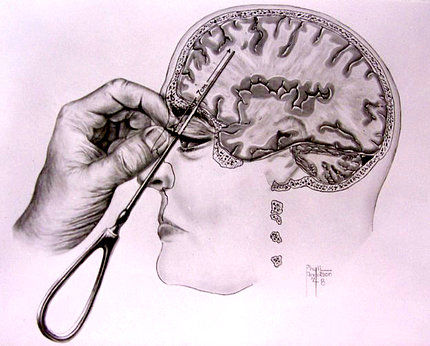Time can heal most anything
- Cecile Bruil
- Articles
- 7 minutes (1381 words)
Time, mystical time, cutting you open, then healing you fine. At least, that is how it usually goes in the case of heartbreaks and gaping wounds. But in the case of brain alterations, there is never a full return to how it was before. This might seem like common sense, but throughout history the human brain and skull was messed with a lot, in hopes of improving it, but often having the exact opposite effect. Let's take a trip down memory lane and amaze ourselves with the ancient brain deformation techniques which are now luckily well in the past. Starting with the least severe alterations and moving our way up to severely unhinged psycho surgery.
Cranial elongation
Aesthetics have always been of interest to humans. Tattoos, piercings, plastic surgery, we alter our bodies permanently to look different, preferably better. One type of modification is cranial elongation. It is very common throughout history, starting around 700 B.C., and still somewhat exists in our society today, mainly in some African tribes. This technique consisted of elastic bands strapped around the head or an apparatus which tightened the skull so much that the cranium would be elongated, resulting in a head with a much larger skull than normally. Nearly every culture on earth has at one point practised this type of skull modification, mostly for aesthetic purposes and to show your wealth and class in society. To make sure the elongation works, the process should start as soon as possible. Children of just a few months old were already strapped into a device that looks like something straight from a torture room. Even though the skull looks very different than normal, the elongation did not do too much damage to the cognitive functions. The process of elongation can be painful and tense at times, but the process is so slow, that all the brain areas get pushed around in the cranium, but they won't deform nor alter cognitive functions. Therefore this is the least damaging modification we will discuss, but once the elongation is done, it can never be returned to a normal state.
Trepanation
This very ancient technique, and I mean hunters and gatherers ancient (around 6000 B.C. to be more precise), is one which raises many questions. The word trepanation comes from the Greek word trypanon which literally means ‘borer’, this is because the technique consisted of boring holes into the skulls of living people using sharp metal objects. But why would you ever bore holes into someone's skull? And they are not small either: the holes can be several centimetres in diameter, causing a pretty big piece of skull to be missing. Also, why were there so many more male skulls with signs of trepanning than female skulls? We will never be able to get a definitive answer, but the most likely theory states that trepanning was used to relieve pressure in the skull, after, for example, a hunter got unconscious after a fight with an animal. This would also explain why more men have trepanation signs, as the men were most often hunting, while the women were gathering goods. The surgery would most likely be performed to ‘wake the patient up’. Suprise suprise, it even worked (or it seems like it), because there are quite some skulls found which show signs of healing, indicating that the patient lived at least a couple of days after the surgery. Not everyone was that lucky, as there are also many skulls with a ‘freshly cut’ trepanation hole, indicating that their last breath was exhaled on the surgery table. Also note that surviving at least a day, is exactly that, researchers find it very unlikely for the hunters to have lived over 14 days after the surgery. It worked when it worked, it didn’t when it didn’t, you would die either way.
Lobotomy
Are you struggling with anxiety, OCD or chronic pain?? Grab an ice pick, and let's fix it. The last technique in this article is certainly the most cruel and life-altering. You might have heard about it, as it is fairly recent that it has been banned. I am talking about lobotomy, although it started out as leucotomy. This predecessor was invented by a Portuguese guy named Antonio Moniz, he thought of a way to cure all mental disorders out there, namely by breaking apart the white matter connections in the prefrontal cortex. The very basic logic behind this makes sense: undo the ‘wrong’ brain connections which cause the mental disorder. But in practice the connections are far more complicated, but that was not well known at the time. The leucotomy consisted of drilling a hole on either side of the skull and infusing the prefrontal cortex with alcohol to damage the brain tissue. This yielded bad results with a side note of some promising cases. And it is these promising results that got Walter Freeman thinking… He adapted the procedure to make it more accessible: stop boring holes in the skull, quit using alcohol, and cut down the elaborate procedure of surgery. Instead, make it a quick 10-min psychiatrist procedure using an ice-pick and a hammer. Use the hammer to slam the ice pick through the eye socket and into the prefrontal cortex, then pivot it around to disrupt the brain tissue. This procedure was so doable that it spread throughout the world, but was most common in the USA and in Europe. In the USA, over 40.000 lobotomies have been performed. But how bad is this procedure? Sure it sounds like torture to be stabbed with an ice pick, but it must have solved the patients complaints for it to be performed so often right?... right? NO. Nearly all people that underwent a lobotomy suffered from the same complaints as before, but more importantly, they became zombies. They lost large parts of their personality, they were not the same as before. Some got seizures, were chronically confused, and lost their sense of self. And that is for the surviving people in which the procedure was successful, this was not a foolproof procedure. You can't expect poking the brain 7cm deep to go well all the time. Around 15% of the time, the lobotomy patient died. Oh and remember that guy Freeman, who made the lobotomy easier to perform, yeah he had gotten quite comfortable with ruining people using ice picks. He even performed lobotomies on children aged 12! In 1967 Freeman was forced to quit performing lobotomies for the rest of his life when yet another patient died.The entire procedure was banned in the rest of the world shortly after. One case example is that of Rosemary Kennedy, sister of president JFK, who suffered from mild cognitive impairment due to a lack of oxygen at birth. When her father forced her to get a lobotomy, however, it went horribly wrong and her competences got reduced to those of a 2 year old, never regaining the ability to walk or talk. Her story (which I recommend looking up as it is crazy) is, like many others, tragic. All patients’ stories are horribly tragic and patients ended up as a shell of what they once were. Therefore I can't fathom that the lobotomy got the Nobel prize for medicine. Lobotomies truly belong on a dark page in history.
Time has taught us many lessons. And has shown that one of these things is not like the others, you can deform a brain with and without severe damage, and you can die in the process or live to tell the tale, but no matter the outcome, the process can’t be reversed. And time will not heal you… Time might improve your trepanation wounds just a tiny bit, but definitely won't fix the brain damage caused by an ice pick or return the shape of your skull after artificial elongation. They say all’s well that ends well, but a successful trepanation or lobotomy leaves you just above death. Lucky for us, these techniques are in the past, buried in ink letters on textbook pages. Never to be performed again, but with the aftermath of stories tattooed in our mind to reminisce about from time to time.



Comments
Log in to read and post comments